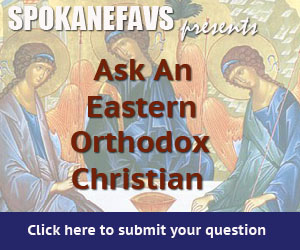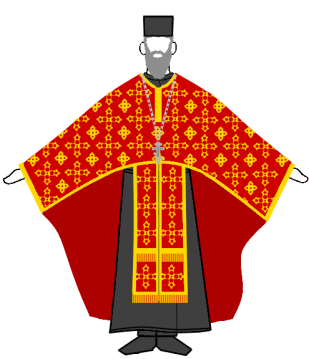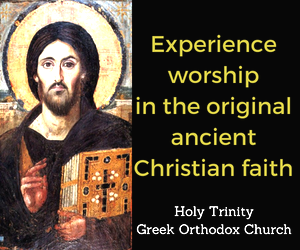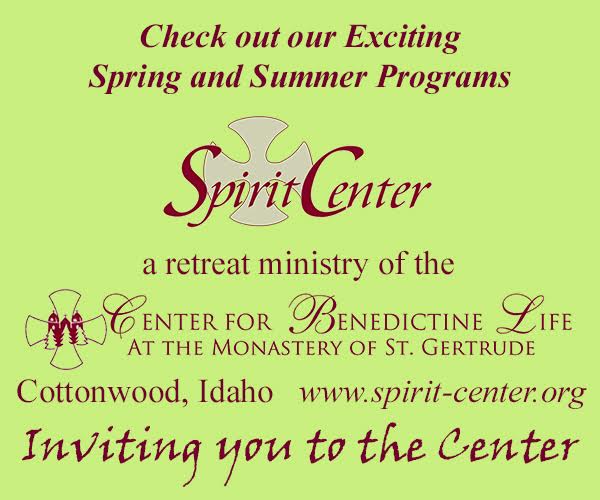What would you like to know about the Eastern Orthodox Christian faith? Submit your question.
Why do Orthodox clergy wear vestments and what do they mean?
 The Lord directed Moses to construct the tabernacle (Ex 25; 1 – 27; 21). Then he established a permanent, hereditary priesthood, beginning with Moses’ brother Aaron and continuing through Aaron’s sons (Ex 28: 1). The priests were sanctified, or consecrated, with holy oil (Ex 30; 22 – 30). Their holy garments of finely woven and richly decorated material were for the honor and glory of God.
The Lord directed Moses to construct the tabernacle (Ex 25; 1 – 27; 21). Then he established a permanent, hereditary priesthood, beginning with Moses’ brother Aaron and continuing through Aaron’s sons (Ex 28: 1). The priests were sanctified, or consecrated, with holy oil (Ex 30; 22 – 30). Their holy garments of finely woven and richly decorated material were for the honor and glory of God.
The above is from the Orthodox Study Bible.
Exodus 28: 2 – 39, garments for the priesthood are described in these 38 verses. “Then you shall make holy garments … a breastplate, an ephod, a full-length robe, a skillfully woven tunic with a fringe, a turban, and a sash ….of gold, blue, purple, and scarlet fabric and fine linen, and you shall make the sash of woven work … shall wear them when they come into the tabernacle of testimony or when they come near the altar of the holy place to minister as priests ….. It shall be an ordinance forever to him (the Levites) and his seed after him.”
The authority of the Levitical priesthood, from the Christian perspective, ended with Christ’s sacrifice on the cross and when the curtain was torn asunder in the Jewish Temple (Mt 27:51).
Orthodox Christians believe that the priesthood of the church is Christ’s priesthood, with the Eucharist as the first-fruit offering. The clergy do not serve in place of Christ; rather, Christ himself serves in them.
There is purpose in what the Lord asks us to do. The temple, the worship in the temple, the decor, and much more is to remind us of heaven. His will and intention for us is to be with him in heaven. Since there is no Jewish Temple, the Orthodox Church has inherited the fullness of the temple tradition. So when someone (non-Orthodox) asks what might heaven be like? The response from an Orthodox Christian might be, “Come taste and see.”
In Isaiah 6 and Revelation 1, one gets a glimpse of God being worshiped in heaven. Clergy attire is part of this “foreshadow” of Heaven and the spiritual edification of the church.
The vestments serve a spiritual function of helping to bring the faithful into the atmosphere of understanding. Vestments are iconic representations of our Lord and the angels, serving at the one altar of God.

The Priest vestments
Pectoral cross, if blessed, is worn on the breast.
Sticharion is a long-sleeved tunic (robe), worn by clergy, reaching to the ground. It is symbolic of the grace of the Holy Spirit covering the priest as with a garment of salvation and joy.
Epimanikia cuffs that are worn around the wrists keeping the inner garments in place and out of the way during the services. The clergy who wear them are reminded that they serve, not by their strength, but with the help of God.
Epitrachelion is one of the most important vestments. It is the priestly stole, worn around the neck down to the feet. It is the symbol of their priesthood, and an Orthodox priest must wear this particular vestment to perform a sacrament. Short tassels extend from this vestment indicating the priest’s responsibility of the souls the faithful in his community.
Zone is a cloth belt worn over the epitrachelion.
Phelonion is a large conical sleeveless garment worn over all other vestments, with the front largely cut away to facilitate the priest’s movements.
Liturgical colors of vestments worn by Orthodox priests
Byzantine practice for liturgical colors are those specific colors that are used in priests vestments, altar covers, and analogion covers (lectern) in the different feast days of the church. The symbolism of colors may serve to underline moods appropriate to a season of the liturgical year or may highlight a special occasion.
- Vestment color: gold (yellow) of all shades.The group of feasts and days commemorating Jesus Christ, the prophets, the apostles, and the holy hierarchs.
- Vestment color: light blue or white.The days and group of feasts commemorating the most holy Mother of God, the bodiless powers, and virgins.
- Vestment color: purple or dark red.The days and group of feasts commemorating the cross.
- Vestment color: of red.The days and group of feasts commemorating the martyrs. Dark red vestments are worn On Great and Holy Thursday, with black, and the holy (altar) table is covered with white cloth.
- Vestment color: shades of green.The days and group of feasts commemorating, Palm Sunday, Pentecost, and the Synaxis of the Holy Spirit (Monday after Pentecost).
- Vestment colors during the Lenten periods are dark blue, purple, dark green, dark red, and black. For the days of Great Lent black is essentially used.






